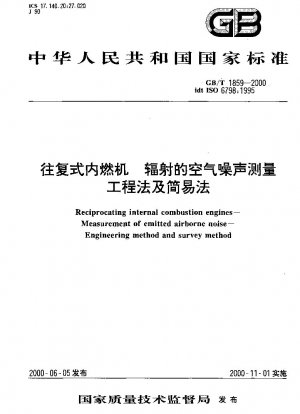GB/T 1859-2000
Reciprocating internal combustion engines-Measurement of emitted airborne noise-Engineering method and survey method (English Version)
- Standard No.
- GB/T 1859-2000
- Language
- Chinese, Available in English version
- Release Date
- 2000
- Published By
- General Administration of Quality Supervision, Inspection and Quarantine of the People‘s Republic of China
- Status
- 2016-07
- Replace By
- GB/T 1859.1-2015
- GB/T 1859.2-2015
- Latest
- GB/T 1859.1-2015
- GB/T 1859.2-2015
- Replace
- GB/T 8194-1987 GB/T 1859-1989
- Scope
- 1.1 This standard specifies the method for calculating the sound power level of a sound source by measuring the sound pressure level on the measurement surface enveloping the sound source. At the same time, the requirements for the test environment and measuring instruments are given, as well as the calculation methods of surface sound pressure level, A-weighted sound power level and octave band or 1/3 octave band sound power level. This standard can be used for acceptance tests. 1.2 This standard is intended to obtain measurement results of an accuracy class 2 (engineering method) (see Table 1). If the background noise correction value is greater than 1.3 dB but less than or equal to 3 dB, and/or the environmental correction value is greater than 2 dB but less than or equal to 7 dB, then obtain the measurement results of level 3 accuracy level (simple method) (see Table 2) . The engineering method "refers to "GB/T 1859 (idt ISO 6798) engineering method"] and the simplified method [refers to "GB/T 1859 (idt ISO 6798) simplified method"] adopts the same rectangular hexahedron measuring surface and microphone position. 1.3 Book The standard is applicable to all reciprocating internal combustion engines within the application scope of GB/T 6072.1 and other applications for which there is no suitable national standard. 1.4 This standard applies to the measurement of noise radiated by reciprocating internal combustion engines under steady-state operating conditions. Appendix A It specifies the noise measurement method of the combustion air inlet or exhaust outlet radiation of reciprocating internal combustion engines. 1.5 The standard deviation of the results measured according to this standard should be equal to or less than the values listed in Table 3. The uncertainties in Table 3 depend not only on The measurement accuracy depends on the sound pressure level and the measurement surface area, but also on the "near-field error" increased by the small measurement distance and low frequency (ie below 250 HZ). This near-field error always makes the The measured sound power level is higher than the actual sound power level.
GB/T 1859-2000 history
- 2015 GB/T 1859.1-2015 Reciprocating internal combustion engines.Measurement of sound power level using sound pressure.Part 1:Engineering method
- 2000 GB/T 1859-2000 Reciprocating internal combustion engines-Measurement of emitted airborne noise-Engineering method and survey method
- 0000 GB/T 1859-1989
- 0000 GB/T 8194-1987
